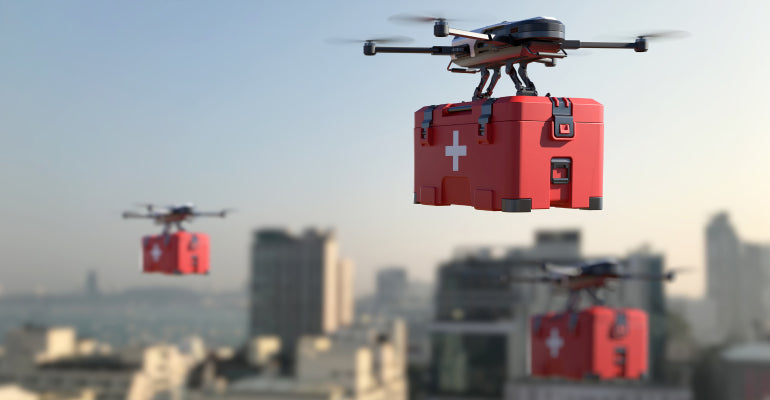Cut-off drones are essential tools for first responders, racing against time in life-saving operations. Drones can arrive at the scene first, provide aerial perspectives, cover vast terrain, deliver supplies, and produce clear images even at night, making them true "air rescuers."
Search and rescue teams using drone technology can significantly increase the chances of rescue and the number of lives saved during natural disasters, accident scenes, and medical emergencies.
The revolutionary role of drones in search and rescue

High-quality search and rescue drones equipped with thermal imaging cameras and GPS systems can quickly locate missing persons during search and rescue missions, especially in remote or dangerous areas such as mountainous areas.
Drone thermal imaging, night vision, and real-time video transmission significantly improve rescue efficiency and increase the chances of finding and rescuing trapped/missing persons.
The Autel EVO II 640T series and EVO Max series thermal imaging drones are equipped with cutting-edge features, making them ideal for field search and rescue operations.

Case Study: Autel Drones Perform SAR Operations for Clarkstown Police Department
Drones' Lifeline Role in Emergency Medical Supply Delivery

Drones are the perfect last-mile delivery service for remote or underserved areas. When natural disasters like earthquakes, mudslides, and tsunamis strike, road access is often blocked. Drones can quickly deliver medical supplies, such as blood, vaccines, or emergency medicine and supply kits like defibrillators, to remote areas or disaster scenes with limited access.
Drones with payload capacity can carry and deploy essential tools like medical kits, flotation devices, or two-way radios, making them indispensable assets for search and rescue teams. This capability ensures rescuers can provide assistance faster and more effectively, even in the most challenging conditions.
Enterprise drones such as the Autel EVO II series, EVO Max series, and Autel Titan all have payload capacities suitable for short-distance emergency deliveries. The Autel Dragonfish e-VTOL drone's 180-minute flight endurance and the Autel Titan's 10kg payload capacity are key deployment capabilities for drones used in material delivery.
Case Study: Global drone delivery companies such as Matternet, Wingcopter, and Zipline have begun drone delivery services for medicines, vaccines, infusions, and common medical supplies, including blood and blood products.
The Critical Role of Drones in Natural Disaster Response

Natural disasters often strike with unpredictable force and cause extensive damage. Ensuring human safety is paramount. Drones can quickly reach the scene to assess the damage, track real-time on-site changes, quickly locate survivors, and deliver supplies.
As first responders, drones offer lower costs, faster deployment, and the ability to enter dangerous areas, reducing the risk to rescuers in adverse conditions. Their real-time dynamic perception further enables rescue teams to formulate strategies and solutions, capitalizing on opportunities.
Autel commercial drones, RTK drones, and other disaster relief drones can serve as first responders at disaster sites, collecting on-site data, delivering supplies, and modeling and mapping damaged areas.

Case Study: Autel Drones Aid Flood Management and Emergency Response
Lifesaving Applications of Drones in Public Safety and Policing

Drones are not only revolutionizing search and rescue teams, but police and fire departments are also using them to save lives through surveillance, evidence collection, and crisis management.
In busy areas, police use drones to monitor traffic flow and conduct post-incident accountability assessments. Thermal imaging drones can also help police quickly track and apprehend suspects at night, enhancing public credibility and social security.
The Autel Enterprise drone series can fully fulfill life-saving applications in public safety and policing, providing valuable support for law enforcement operations.

Case Study: Autel 640T Thermal Imaging Drone Helps Nevada State Police Catch Fugitive Suspects
The Contribution of Drones to Wildlife Conservation and Ecological Rescue

We must prioritize not only the safety of people but also the lives of animals. Drones indirectly save both human and animal lives by monitoring wildlife, combating poaching, and assessing ecological disasters.
Drones can provide long-range, non-invasive aerial photography of wildlife, focusing on monitoring wildlife population activity. Farmers can use drones to manage livestock, preventing them from escaping, being eaten by large predators, or otherwise invading farms.
Autel thermal imaging drones and the EVO Max series can monitor wildlife around the clock, contribute to ecological conservation, and promote a balance between humanity and nature.
Case Study: Drones Revolutionize Wild Elephant Conservation
The Importance of Drones in Saving Lives

The convenience and efficiency of drones allow them to detect signs of life immediately, initiate large-scale aerial search and rescue operations, gather real-world data, expedite command center decision-making, and save lives faster.
Equipped with thermal imaging sensors, high-definition cameras, gas detection sensors, LiDAR, laser rangefinders, Loudspeaker, Spotlight, and a drop system, rescue drones can easily access dangerous areas, ensure the safety of rescuers, and deliver life-saving supplies.
With the development of AI, 5G, and automation technologies, the capabilities of drone rescue will be further enhanced in the future, including but not limited to automatic life detection, swarm collaboration, long flight endurance, and all-weather operation, significantly enhancing rescue capabilities.
Conclusion
Drones Save Lives is an innovative intelligent solution for the search and rescue industry. From search and rescue to medical delivery, from public safety to ecological protection, the use of drones is changing our understanding of rescue and life safety.
In the future, drones will not only be standard equipment for professional rescue teams, but will also be introduced into more communities, businesses, and homes, becoming a vital guardian of life safety.








